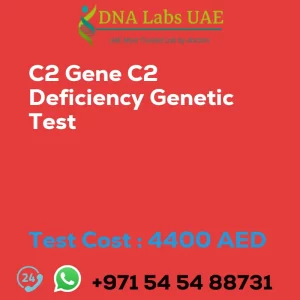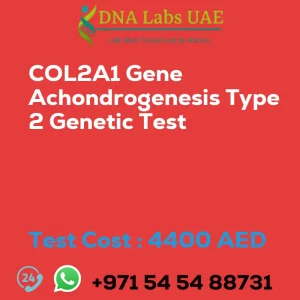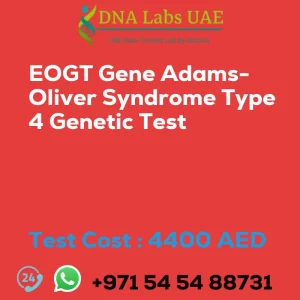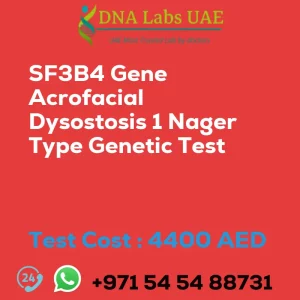VIPAS39 Gene Arthrogryposis Renal Dysfunction and Cholestasis Type 2 Genetic Test
Welcome to DNA Labs UAE, where we offer the VIPAS39 Gene Arthrogryposis Renal Dysfunction and Cholestasis Type 2 Genetic Test. This test is designed to diagnose individuals with a rare genetic disorder called Arthrogryposis, Renal Dysfunction, and Cholestasis type 2 (ARCND2).
Test Details
The VIPAS39 gene is associated with ARCND2, a disorder characterized by joint contractures (arthrogryposis), kidney dysfunction (renal dysfunction), and liver dysfunction (cholestasis). Our NGS (Next-Generation Sequencing) technology allows us to analyze multiple genes simultaneously and identify genetic variations or mutations.
By specifically examining the VIPAS39 gene, we can identify the mutations responsible for causing ARCND2. This information is crucial for diagnosing individuals with the disorder and providing appropriate medical care.
Components and Price
The VIPAS39 Gene Arthrogryposis Renal Dysfunction and Cholestasis Type 2 Genetic Test is priced at 4400.0 AED. The test can be conducted using either blood, extracted DNA, or one drop of blood on an FTA Card.
Report Delivery and Method
After conducting the test, the report will be delivered within 3 to 4 weeks. Our method of analysis, NGS technology, ensures accurate and efficient results.
Test Type and Doctor
The VIPAS39 Gene Arthrogryposis Renal Dysfunction and Cholestasis Type 2 Genetic Test falls under the category of Osteology Dermatology Immunology Disorders. This test is conducted by our experienced dermatologist in our Genetics department.
Pre Test Information
Prior to conducting the VIPAS39 Gene Arthrogryposis Renal Dysfunction and Cholestasis Type 2 Genetic Test, it is important to provide the clinical history of the patient. Additionally, a genetic counseling session will be conducted to draw a pedigree chart of family members affected by ARCND2.
Conclusion
The VIPAS39 Gene Arthrogryposis Renal Dysfunction and Cholestasis Type 2 Genetic Test is a valuable diagnostic tool for identifying mutations in the VIPAS39 gene associated with ARCND2. This test can be used for diagnosis, carrier testing, prenatal testing, and genetic counseling for families with a history of the disorder. At DNA Labs UAE, we are committed to providing accurate and reliable genetic testing services.
| Test Name | VIPAS39 Gene Arthrogryposis renal dysfunction and cholestasis type 2 Genetic Test |
|---|---|
| Components | |
| Price | 4400.0 AED |
| Sample Condition | Blood or Extracted DNA or One drop Blood on FTA Card |
| Report Delivery | 3 to 4 Weeks |
| Method | NGS Technology |
| Test type | Osteology Dermatology Immunology Disorders |
| Doctor | Dermatologist |
| Test Department: | Genetics |
| Pre Test Information | Clinical History of Patient who is going for VIPAS39 Gene Arthrogryposis, renal dysfunction, and cholestasis type 2 NGS Genetic DNA Test. A Genetic Counselling session to draw a pedigree chart of family members affected with VIPAS39 Gene Arthrogryposis, renal dysfunction, and cholestasis type 2 NGS Genetic DNA Test gene VIPAS39 |
| Test Details |
The VIPAS39 gene is associated with a rare genetic disorder called Arthrogryposis, Renal Dysfunction, and Cholestasis type 2 (ARCND2). This disorder is characterized by joint contractures (arthrogryposis), kidney dysfunction (renal dysfunction), and liver dysfunction (cholestasis). NGS (Next-Generation Sequencing) genetic testing is a method used to analyze multiple genes simultaneously and identify genetic variations or mutations. In the case of ARCND2, NGS genetic testing can be used to identify mutations in the VIPAS39 gene, which is responsible for causing the disorder. By identifying the specific mutation in the VIPAS39 gene, NGS genetic testing can help in diagnosing individuals with ARCND2. It can also be used for carrier testing, prenatal testing, and genetic counseling for families with a history of ARCND2. Overall, the VIPAS39 gene Arthrogryposis, renal dysfunction, and cholestasis type 2 NGS genetic test is a diagnostic tool used to identify mutations in the VIPAS39 gene associated with ARCND2. |








